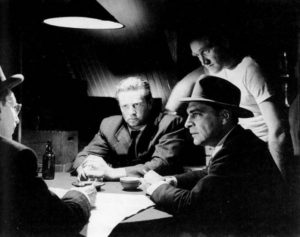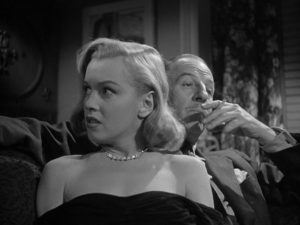STUDIO: Criterion | DIRECTOR: John Huston | CAST: Sterling Hayden, Louis Calhern, Jean Hagen, James Whitmore, Sam Jaffe, John McIntire
RELEASE DATE: 12/13/16 | PRICE: DVD $29.95, Blu-ray $26.19
BONUSES: Pharos of Chaos documentary about Sterling Hayden, 1979 interview with John Huston, interviews with film historian Eddie Muller and John Bailey, audio interview with Huston, essay by Geoffrey O’Brien
SPECS: NR | 112 min. | Crime drama | 1.37:1 fullscreen | mono
Even if you haven’t seen The Asphalt Jungle (1950), you’re familiar with its plotline, as it is the first modern “caper movie” that shows the planning, execution and unplanned screw-ups that threaten a group of crooks carrying out a heist.
The basic scenario has been copied endlessly, from Kubrick’s The Killing (1956) to Tarantino’s Reservoir Dogs (1992), but the earnestness and downbeat tone of John Huston’s original — plus the superb performers and the strikingly memorable photography of Harold Rosson — make it one of the best crime films ever made.
Histories of the film noir often posit Huston’s The Maltese Falcon (1941) as the film that best prefigures the noir “cycle” (which began in earnest in ’44). The thing that unites the pre-noir Falcon and the incredibly dark Asphalt Jungle is that they are both of a piece with the rest of Huston’s best pictures — portraits of driven individuals who strive but ultimately fail in an irrevocable fashion.
 Huston was a master at literary adaptation and so his choice of crime fiction was top notch — Jungle was written by W.R. Burnett, who could be said to have single-handedly created the gangster movie, with Little Caesar and High Sierra and his work on the script of Scarface. Huston’s film stays quite close to its source material, but also benefits from an incredible cast of character people (surpassed only by Kubrick’s Killing) and atmospheric cinematography by Rosson (who shot more than 150 movies, including The Wizard of Oz).
Huston was a master at literary adaptation and so his choice of crime fiction was top notch — Jungle was written by W.R. Burnett, who could be said to have single-handedly created the gangster movie, with Little Caesar and High Sierra and his work on the script of Scarface. Huston’s film stays quite close to its source material, but also benefits from an incredible cast of character people (surpassed only by Kubrick’s Killing) and atmospheric cinematography by Rosson (who shot more than 150 movies, including The Wizard of Oz).
Woven into the “caper” plotline are a number of smaller plot strands, each of which outline the yearnings that have doomed the characters — Dix (Sterling Hayden, Johnny Guitar) wants to leave the city and return to his country home, Alonzo (Louis Calhern) needs more money to satisfy his wife and mistress (Marilyn Monroe, Love Happy), and the brains of the team, “Doc” (Sam Jaffe, Ben-Hur), has a lust for young women that is sure to be his downfall.
The film is thus not only a classic noir but a group character study. It also stands as perhaps the last quintessential “straightforward” noir before the explosion of higher-key, frenzied pictures made in the Fifties (The Big Heat, Kiss Me Deadly, Touch of Evil). As such it deserves the many enlightening and entertaining supplements that are included in this two-disc package. Nearly all are new, with the exception of an audio commentary by film historian Drew Casper, who delivers his thoughts on the film in a hushed voice worthy of a Seventies late-night “free form” disc jockey.
His commentary first appeared on the 2004 Warner release of the film, and includes segments from an interview with co-star James Whitmore (Black Like Me), who lets us know Huston’s reaction to his initial costume fitting (he played a hunchbacked lunch counter owner who becomes part of the heist team). The director told him, “you look like a towel boy in a Mexican whorehouse.”
The supplements that are exclusive to this release cover a lot of ground. Film historian Eddie Mueller discusses how faithful Huston’s film is to Burnett’s original novel. This is underscored by an audio interview with Huston in which he talks about his desire to remain faithful to his source material. He also declares that he tells actors “as little as possible” (coincidentally, the key line in Chinatown), and doesn’t want to see the “mechanics of good acting” in his films.
Cinematographer John Bailey (The Big Chill, A Brief History of Time) supplies a fascinating tribute to Harold Rosson’s work on The Asphalt Jungle. Bailey notes that Rosson’s evocative work on the film consists not only of classic noir imagery but also carefully composed visuals. Bailey’s analysis of one key sequence, a long take with Hayden and co-star Jean Hagen (Singin’ in the Rain) talking, lays bare Rosson’s approach to the film’s look and tone.
A full 1979 episode of the Canadian series City Lights with Huston guesting is entertaining for reasons intended and unintended. On the latter front, the show will delight SCTV fans, as the interviewer is Brian Linehan – portrayed on SCTV as “Brock Linehan” by Martin Short. Linehan’s style of interviewing is amazing to watch, as he did an immaculate amount of research about his guest and then would ask them to talk about things they had done and said, prefacing most questions with a set-up like “Is it true that…?”
Linehan’s knowledgeable but highly eccentric mode of interviewing does hit paydirt, as when he talks with Huston about the films that were his favorites from the Sixties and Seventies. By naming only four pictures (Reflections in a Golden Eye, Fat City, The Man Who Would be King and the then-current Wise Blood), it becomes apparent that he knew he did quite a lot of substandard films (with many works for hire) in that time. Huston also offers his thoughts on the writing of his autobiography An Open Book, which, he says, forced him to think about several unpleasant moments in his life.
 The best supplement in the package, though, is the two-hour 1983 documentary Pharos of Chaos (never before released in the U.S. on VHS or DVD). The film is a portrait of Sterling Hayden in the early Eighties, as he was living on a boat he had docked just outside of Paris. It’s an amazing portrait of a haunted man who was filled with self-loathing, even when things were going well in his life and career (after The Godfather, Hayden appeared in several films as a supporting actor and commanded a high enough salary to live as he wished).
The best supplement in the package, though, is the two-hour 1983 documentary Pharos of Chaos (never before released in the U.S. on VHS or DVD). The film is a portrait of Sterling Hayden in the early Eighties, as he was living on a boat he had docked just outside of Paris. It’s an amazing portrait of a haunted man who was filled with self-loathing, even when things were going well in his life and career (after The Godfather, Hayden appeared in several films as a supporting actor and commanded a high enough salary to live as he wished).
A narrator acknowledges that the filmmakers began the shoot at a time when Hayden was drinking heavily (he also is seen smoking hashish at various points). At his lowest point, Hayden apologizes to them onscreen but tells them “you have gotten a record of what alcoholism is.”
As the films proceeds, Hayden is seen in a more sober state, declaring that he dislikes acting and did it only to get money to continue his life as a sailor (a lifestyle he began as a teenager). He also talks at great length about his guilt over “naming names” in front of The House Un-American Activities Committee. All of Pharos is rather sad and touching, but these scenes are especially moving, as Hayden’s regret over costing several people their livelihoods is palpable.
Hayden notes he “despised” himself for falling into and out of acting, but professes a deep affection for three films he appeared in: Dr. Strangelove, The Long Goodbye and – the only picture he liked from the dozens he made in Hollywood’s “Golden Age” – The Asphalt Jungle.
|
Buy or Rent The Asphalt Jungle
|
|||
|---|---|---|---|
 |
|||
Leave a Reply